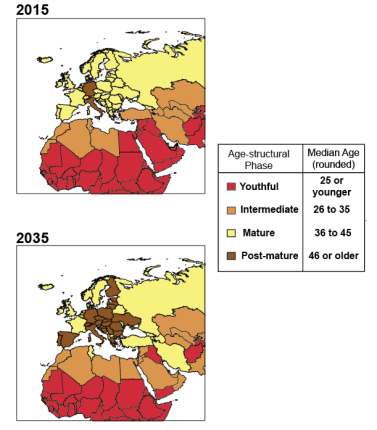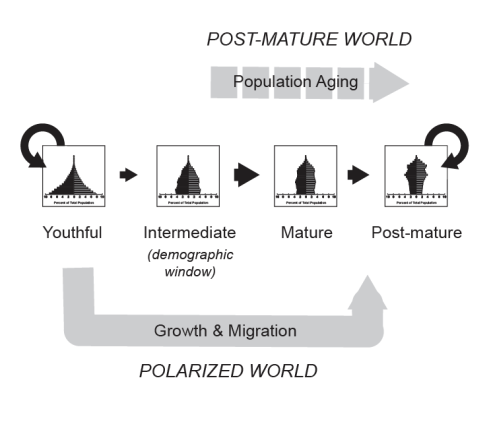-
Which Demographic “End of History”?
December 9, 2019 By Richard Cincotta First published 30 years ago in the National Interest, Francis Fukuyama’s landmark essay, “The End of History?,” argued that, with the fall of fascism and communism, no serious blueprint for modern-state development lay open, save for those paths that would ultimately embrace both political and economic liberalism. Over the past two decades, movement toward this ideal end-state has trickled to a halt. Instead, the political elites of Eurasia’s regional powers—Russia, Turkey, Iran, and China—have crafted stable illiberal regimes that borrow whatever they need from free-market economics, electoral politics, nationalism, and religion. Their ascent has produced a form of “non-endpoint stability”—two mutually antagonistic camps: one composed of liberal democracies, the other a mix of illiberal hybrids. As long as these camps remain stable, the international system falls far short of Fukuyama’s theoretical end of history.
First published 30 years ago in the National Interest, Francis Fukuyama’s landmark essay, “The End of History?,” argued that, with the fall of fascism and communism, no serious blueprint for modern-state development lay open, save for those paths that would ultimately embrace both political and economic liberalism. Over the past two decades, movement toward this ideal end-state has trickled to a halt. Instead, the political elites of Eurasia’s regional powers—Russia, Turkey, Iran, and China—have crafted stable illiberal regimes that borrow whatever they need from free-market economics, electoral politics, nationalism, and religion. Their ascent has produced a form of “non-endpoint stability”—two mutually antagonistic camps: one composed of liberal democracies, the other a mix of illiberal hybrids. As long as these camps remain stable, the international system falls far short of Fukuyama’s theoretical end of history.
First published 30 years ago in the National Interest, Francis Fukuyama’s landmark essay, “The End of History?,” argued that, with the fall of fascism and communism, no serious blueprint for modern-state development lay open, save for those paths that would ultimately embrace both political and economic liberalism. Over the past two decades, movement toward this ideal end-state has trickled to a halt. Instead, the political elites of Eurasia’s regional powers—Russia, Turkey, Iran, and China—have crafted stable illiberal regimes that borrow whatever they need from free-market economics, electoral politics, nationalism, and religion. Their ascent has produced a form of “non-endpoint stability”—two mutually antagonistic camps: one composed of liberal democracies, the other a mix of illiberal hybrids. As long as these camps remain stable, the international system falls far short of Fukuyama’s theoretical end of history.
A similar type of stability is overtaking demography’s own end of history. Demography’s theoretical end-state is a set of hard-to-escape conditions (Fig. 1) typified by low and often sub-replacement levels of fertility, large proportions of retirees, and an aging workforce—an endpoint that the National Intelligence Council’s Global Trends reports refer to as post-maturity. The shift toward post-maturity is so unrelenting in parts of Europe and East Asia that some analysts imagine humanity plunging globally into post-maturity. However, this scenario, which I call “Post-mature World,” is looking much less likely than its non-endpoint alternative, a chronically demographically “Polarized World.”

The Polarized World is typified by two zones. One, located in the Sahel, and West and Central Africa (SWC Africa), is transfixed in the hard-to-escape conditions characteristic of the Global Trends youthful phase: low educational and legal status among women, high desired family size, rapid rates of workforce growth coupled with low levels of economic opportunity, and high risks of recurring political violence—so much insecurity that state-run services come to a standstill in some parts of the country. The other zone, located in Europe, North Africa, and elsewhere, continues at various rates toward post-maturity. While geographically separate, these two zones are likely to be connected by difficult-to-control outflows of migrants and wrenched apart politically by anti-immigrant nationalism in migrant-destination countries.

Which World?
Developments in SWC Africa over the next few decades will likely determine whether coming generations will experience the Polarized World. For analysts trying to identify early signs that these regions might avoid this scenario, look for indications of renewed international commitments to SWC Africa, climbing levels of education among girls, as well as an upward swing in contraceptive use. However, regardless of positive indications of development, the scale of SWC Africa’s problems are growing. The UN Population Division’s medium variant projects that SWC Africa’s population will climb from just over 490 million today, to about 800 million by 2040.
If a Polarized World settles in, analysts will note slow or non-existent progress in these indicators. Other signs could include persistent high-intensity conflict and economic stagnation, accelerating the flow of migrants and the rise of populist anti-immigrant nationalism in frontline states and Europe. How long can this Polarized World persist? Think along the lines of Afghanistan, Iraq, and Syria—the decades of US and frontline-state involvement in those youthful states, plus the unknown number of future decades in which armed conflict is likely to persist.
Richard Cincotta is a global fellow at the Wilson Center and non-resident fellow at the Stimson Center. He wishes to thank Population Institute for its support of this research.
Sources: Global Trends, Michigan State University, United Nations
Photo Credit: Salvador, Brazil, June 2011. Photo by Adam Reeder.
 A Publication of the Stimson Center.
A Publication of the Stimson Center.

 First published 30 years ago in the National Interest, Francis Fukuyama’s landmark essay, “
First published 30 years ago in the National Interest, Francis Fukuyama’s landmark essay, “



